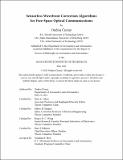Sensorless Wavefront Correction Algorithms for Free-Space Optical Communications
Author(s)
Čierny, Ondrej
DownloadThesis PDF (4.021Mb)
Advisor
Cahoy, Kerri L.
Terms of use
Metadata
Show full item recordAbstract
Free-space optical communications (FSOC) technology facilitates high-throughput wireless links across large distances with low size, weight, and power (SWaP) terminals. However, it is difficult to design reliable, low-cost FSOC terminals for long-range links through the atmosphere. Even in clear conditions, the effects of air turbulence along such links usually necessitate active wavefront correction via adaptive optics (AO). Conventional AO algorithms rely on direct wavefront sensing, an approach that is high in cost and SWaP and usually degrades in strong atmospheric scintillation. Sensing methods that are more tolerant to scintillation have been developed, but they are often more challenging to implement and further increase cost and SWaP.
Sensorless wavefront correction algorithms, such as stochastic parallel gradient descent (SPGD), are preferable in terms of cost and SWaP, and have been used in FSOC terminals as methods to optimize the received signal strength indicator (RSSI). A key challenge with such algorithms, however, is that their convergence rate degrades as more atmospheric modes are optimized. This can lead to an inadequate correction rate due to limited bandwidth of the AO element and cause link interruptions. To maintain a sufficient link margin in such conditions, correction algorithms with better convergence properties are needed.
This thesis focuses on the development and testing of a new non-stochastic algorithm for multimodal wavefront correction and a more general analysis of the circumstances where sensorless algorithms attain adequate performance for FSOC, including in strong scintillation. An end-to-end simulation environment is built to compare SPGD with the developed non-stochastic algorithm over a range of atmospheric conditions and hardware configurations. We show that in identical conditions, the non-stochastic algorithm either improves the link margin by 2--3 dB or relaxes the AO element bandwidth requirement by a factor of 2--3 compared to SPGD. Finally, the simulation results are validated in the laboratory under simulated atmospheric turbulence and compiled into a useful design tool for predicting sensorless wavefront correction performance.
Date issued
2023-06Department
Massachusetts Institute of Technology. Department of Aeronautics and AstronauticsPublisher
Massachusetts Institute of Technology